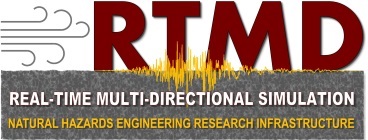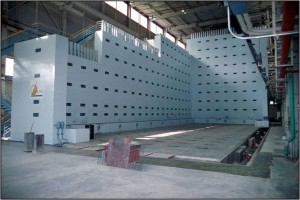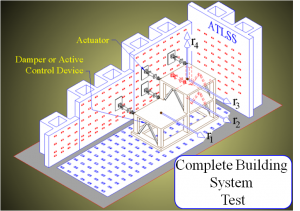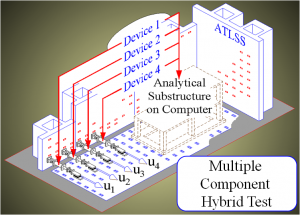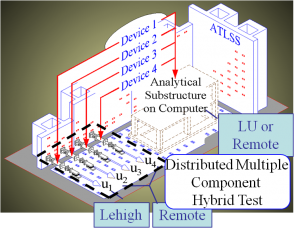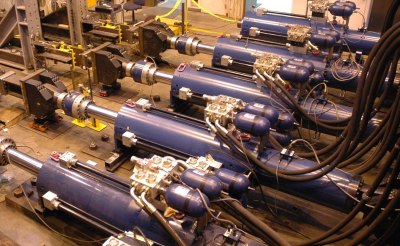Lehigh University Experimental Facility
Overview
[expand expanded=”true”]
To help meet the grand challenge of community resilience to natural hazards, the Natural Hazards Engineering Research Infrastructure (NHERI) Lehigh Experimental Facility (EF) was funded by the National Science Foundation (NSF) to be a world-class, open-access facility that enables researchers to address key research questions associated with the challenge of community resilience. The NHERI Lehigh EF has a unique portfolio of equipment, instrumentation, infrastructure, testbeds, experimental simulation control protocols, large-scale simulation and testing experience along with know-how that does not exist elsewhere in the United States. The unique strength of the NHERI Lehigh EF is accurate, large-scale, multi-degree-of-freedom and multi-directional simulations of the effects of natural hazard events on civil infrastructure systems (i.e., buildings, bridges, industrial facilities, etc.) with potential soil-foundation effects.
The types of laboratory simulations and tests enabled by the NHERI Lehigh EF include:
- Hybrid simulation (HS) which combines large-scale physical models with computer-based numerical simulation models.
- Geographically distributed hybrid simulation (DHS) which is a HS with physical models and/or numerical simulation models located at different sites.
- Real-time hybrid earthquake simulation (RTHS) which is a HS conducted at the actual time scale of the physical models.
- Geographically distributed real-time hybrid earthquake simulation which combines DHS and RTHS.
- Dynamic testing (DT) which loads large-scale physical models at real-time scales through predefined load histories.
- Quasi-static testing (QS) which loads large-scale physical models at slow rates through predefined load histories.
Equipment Portfolio
[expand]
The Lehigh EF has the capabilities to perform real-time testing using the effective force method, pseudo-dynamic testing method, or the pseudo-dynamic hybrid testing method for the testing of large-scale structural components, structural sub-assemblages, and super-assemblages under earthquake excitations. The laboratory includes a strong floor that measures 31.1m x 15.2 m in plan, and reaction walls up to 15.2 m in height. Anchor points are spaced on a 1.5-m grid along the floor and walls. Each anchor point can resist 1.33 MN tension force and 2.22 MN shear force. Additional steel framing is used in combination with the strong floor and reaction walls to create a wide variety of test configurations. A 178-kN capacity overhead crane services the test area and an adjacent fabrication area. Additional smaller cranes with capacities of 45-kN and 27-kN also serve this area. The hydraulic system, combined with the dynamic actuators and a real-time digital servo-control system, enables real-time strong ground motion effects; sustainable for up to 30 seconds. The facility also supports multi-site pseudo-dynamic hybrid testing.
The equipment portfolio and resources of the Lehigh EF include:
- Five channels of dynamic loading, with the system configured for up to 8 channels and control by using either displacement or force, consisting of two 2050 kN dynamic actuators ported for three 400 gpm servovalves, +/- 500 mm stroke, and three 1500 kN dynamic actuators ported for three 400 gpm servovalves, +/- 500 mm stroke.
- Ten three-stage 1500 liters/min (400 gpm) high flow-rate servo-valves.
- Hydraulic distribution lines and service manifolds, with a low-pressure and high-pressure setting, to operate at 20.7 MPa (3000 psi) with a maximum flow of 1500 liters/min (400 gpm). Surge tank and three banks of accumulators that will enable strong ground motion effects to be sustained for up to 30 seconds. Each bank will consist of twelve 114-liter (30 gallon) accumulators, to supply a total accumulated oil supply of 4090 liters (1080 gallons).
- Hydraulic system modifications, to connect the accumulators to the pressure line of the existing system, add dedicated connections for the new, high-flow hydraulic service manifolds, add a new return line from these dedicated connections to the pump house area, and add a new hydraulic oil reservoir in the pump house area for the oil needed to fill the accumulators and to receive the return flow, as well as make connections of this reservoir to the existing reservoirs, heat exchangers, and pumps.
- Two hydraulic control systems with real-time hybrid control packages, with each channel of the controller designed to follow an independent, random load, or displacement history.
- Simulation system consisting of a host workstation and SIMULINK Real-Time systems which apply the algorithms that generate commands for actuators. The SIMULINK RT systems synchronize data channels from the control system and data acquisition system with simulation data and triggers camera snapshots aligned with simulation data. Support for MATLAB and LabVIEW configurations along with RTMD hybrid testing protocols.
- High speed 304-channel data acquisition system, capable of acquiring data at 4096 Hz (4096 samples per second) per channel and expansion to 384 channels.
- Trilion Aramis 3D Image Correlation System to provide three-dimensional deformation and strain distributions measurements for objects.
[/expand]
Experimental Protocol
[expand]
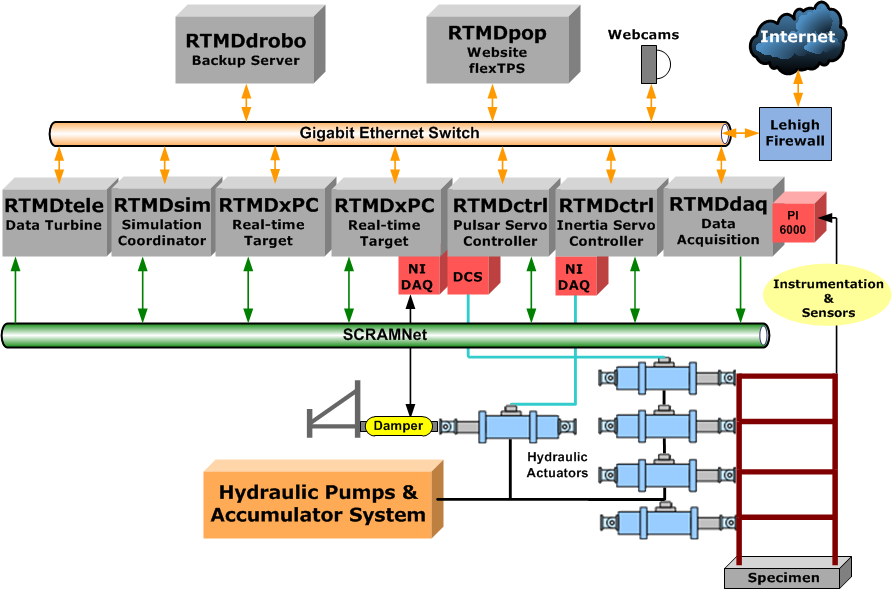
The Real-time Integrated Control System is configured with the experimental protocol required by the user to perform their test. The algorithms to perform the different types of tests mentioned in the Science Plan reside on the RTMDxPC, which is a dedicated real-time xPC kernel. The algorithms were implemented by developing software that was cited above, and which will be discussed further below. All of the algorithms have been created in Simulink on the simulation coordinator (RTMDsim), and Simulink Real-Time from MathWorks, Inc. (Matlab 2014) is used to recreate real-time executable code that is subsequently loaded onto an RTMDxPC. If the experiment requires large computational models with many degrees-of-freedom to create the analytical substructure, then the executable code is parallelized and placed onto two RTMDxPCs such that multi-grid processing can be used to run a large experiment in real time (Chae et al. 2012). The Real-Time Integrated Control System uses SCRAMNet to enable communication among the telepresence server (RTMDtele), the simulation coordinator (RTMDsim), real-time target PC (RTMDxPC), the servo-hydraulic controllers (RTMDctrl), and data acquisition system (RTMDdaq). The data exchange across SCRAMNet occurs within 90 nanoseconds, essentially enabling shared memory among the workstations, thus enabling real-time testing capabilities. Synchronization is maintained through the use of a pulse trigger placed on SCRAMNet at the rate of 1024Hz. A data structure for SCRAMNet is in place that includes multiple states for commands and feedback signals, enabling advance servo-hydraulic control laws to be implemented to meet user needs and complex testing methods to be performed. Experiments can be run in real-time (e.g., real-time earthquake hybrid simulation, distributed real-time hybrid earthquake simulation, dynamic testing), or at an expanded time scale (e.g., hybrid simulation, distributed hybrid simulation, quasi-static testing). The Real-Time Integrated Control System is operated in distributed hybrid simulation mode using either UI-Simcor (Kwon et al. 2005), OpenFresco, or custom software. The System is robust and of a flexible design, enabling software and middleware packages developed by the NEHRI CI or users to be plugged into the System and utilized for conducting tests.
The integrated control system has a hydraulics-off simulation mode for use in validation of testing methods, training, and education. In the hydraulics-off simulation mode, the servo-hydraulic equipment (e.g., actuators, servo-valves) and test structure are analytically modeled. Models of the servo-hydraulic equipment have been developed in Simulink for this purpose, and have been calibrated based on system identification tests of the equipment (Zhang et al. 2005). To ensure the safety of personnel and equipment during a test, software limits are enabled on the RTMDxPC and RTMDctrl, hardware piston stroke limit switches are placed on the actuators, and an emergency stop system is activated throughout the laboratory.
For hybrid simulation, numerous options exist for creating the analytical substructure. The open-source program HybridFEM has been developed by Karavasilis et al. (2009) that enables analytical substructures to be created using embedded MATLAB functions in a Simulink model. The source code can be compiled and run in real-time to conduct real-time hybrid simulations. HybridFEM has an element library that includes nonlinear fiber elements, nonlinear panel zone elements, nonlinear hysteretic connection elements, nonlinear geometric elements based on the co-rotational formulation (to model the P-Δ effect), along with a material library that enables the hysteretic stress-strain behavior of steel, concrete, and reinforcement to be modeled. User-defined elements can be readily added to HybidFEM. HybridFEM has been successfully used on numerous projects by users to conduct a variety of types of experiments, including real-time hybrid simulations of structural systems (Mercan et al. 2008, Chen et al. 2009, Karavasilis et al. 2011a, Chen and Ricles 2011a,b, Chen et al. 2012, Chae et al. 2013a, 2014, Cha et al. 2013, 2014, Friedman et al. 2014, Kolay et al. 2014, Dong et al. 2014a,b). Translator software can be used to convert an OpenSees model to use in HybridFEM. The option also exists to use OpenSees on the RTMDsim for conducting hybrid simulations. OpenFresco is used to provide the interface between OpenSees (where the analytical substructure and integration algorithm resides) and the experimental substructure (Marullo et al. 2008).
Hybrid simulations are conducted using explicit integration algorithms developed by the PI (Chen and Ricles 2008, Chen et al. 2009, Kolay and Ricles 2014, Kolay et al. 2014). These algorithms are unconditionally stable, have second-order accuracy, and do not require iteration to satisfy equilibrium of the equations of motion (making them ideal for real-time hybrid simulation). One of these algorithms is based on the KR-α method. In addition to being unconditionally stable and 2nd order accurate, the KR-α method features controllable numerical energy dissipation (i.e., numerical damping), enabling it to be used to model structures that develop significant nonlinear response involving fracture or strength degradation (e.g., non-ductile reinforced concrete structures that develop cyclic member cracking and strength degradation, Kazemibidokhti et al. 2014).
The target displacements of a test structure (i.e., experimental substructure) are precisely achieved in real-time using an actuator control law that is based on an advanced adaptive delay compensation algorithm developed by the PI (Chae et al. 2013d). The algorithm uses feedback signals from the measured state of the test structure to ensure that the test structure target displacements are accurately achieved. This is accomplished by avoiding displacement errors from developing in the simulation due to both actuator and test fixture dynamics (Dong et al. 2014b, Chae 2014). For multi-directional experiments it is necessary to correct for kinematic errors in real-time that effect actuator control. The testing protocol uses kinematic compensation to avoid developing kinematic errors in multi-directional experiments that is based on an algorithm developed by the PI (Mercan et al. 2009). The algorithm accounts for the precise displaced configuration of the test structure and the actuators in determining the actuator command displacement signals issued to the servo-controller (RTMDctrl).
Real-time telepresence is available using teleobservation and tele-operation equipment (RTMDtele) that is tied to the testing systems using discrete and global sensors, including high-resolution digital video and imaging capabilities, making it possible for remote collaborators and observers to access the Lehigh EF. Real-time structural system animation software has been developed (RDV 2014) to enable the real-time visualization of the response of the complete system, including analytical and experimental substructures that exist in hybrid simulations. The experimental protocol includes the use of the Lehigh Data Model (Lee et al. 2008) described in the RTMD User’s Manual to define the experiment, and enables post-testing use of archived data from a hybrid simulation that is more complete.
- Cha, Y.J., Zhang, J., Agrawal, A., Friedman, A., Phillips, B., Ahn, R., Dong, B., Dyke, J., Spencer, B., Ricles, J., and Christenson, R. (2014). “Performance Validations of Semi-Active Controllers on a Large-Scale Moment Resisting Frame Equipped with a 200 KN MR Damper Using Real-Time Hybrid Simulations,” Journal of Structural Engineering, ASCE, 140(10), 10.1061/(ASCE)ST.1943-541X.0000982
- Dong, B., Sause, R., and Ricles, J.M. (2014a). “Accurate Real-time Hybrid Earthquake Simulations on Large-scale MDOF Steel Structure with Nonlinear Viscous Dampers,” Earthquake Engineering and Structural Dynamics, submitted for publication.
- Dong, B., Sause, R., and Ricles, J.M. (2014b). “Real-Time Hybrid Simulation: Validation of PBD Procedure for Steel Frames with Nonlinear Viscous Dampers,” Proceedings, 10th US National Conference on Earthquake Engineering, Anchorage.
- Friedman, A., Dyke, S., Phillips, B., Ahn, R., Dong, B., Chae, Y., Castaneda, N., Jiang, Z., Zhang, J., Cha, Y., Ozdagli, A., Spencer, B., Ricles, J., Christenson, R., Agrawal, A., and Sause, R., (2014). “Large-Scale Real-Time Hybrid Simulation for Evaluation of Advanced Damping System Performance, ” Journal of Structural Engineering, ASCE, 10.1061/(ASCE)ST.1943-541X.0001093, 04014150,.
- Kazemibidokhti, K., Kolay, C., Ricles, J., and Sause, R. (2014). “Large-Scale Real-time Hybrid Simulation of Reinforced Concrete Structures,” Proceedings, 6th World Conference on Structural Control and Monitoring, Barcelona, Spain, July 15-17.
- Kolay, C., & Ricles, J.M. (2014). “Development of a Family of Unconditionally Stable Explicit Direct Integration Algorithms with Controllable Numerical Energy Dissipation,” Earthquake Engineering and Structural Dynamics, 43(9), 1361–1380. doi:10.1002/eqe.2401.
- Kolay, C., Ricles, J.M, Marullo, T., Mahvashmohammadi, A., and Sause, R. (2014). “Implementation and Application of the Unconditionally Stable Explicit Parametrically Dissipative KR-α Method for Real-Time Hybrid Simulation” Earthquake Engineering and Structural Dynamics, doi:10.1002/eqe.2484, 2014.
- Cha Y.J., Zhang, J., Agrawal, A.K., Dong, B., Friedman, A., Dyke, S.J., and Ricles, J.M. (2013). “Comparative Studies of Semi-active Control Strategies for MR Dampers: Pure Simulation and Real-Time Hybrid Tests.” Journal of Structural Engineering, ASCE, 139(7), 1237-1248.
- Chae, Y, Ricles, J.M., and Sause, R. (2013a). “Large-Scale Experimental Studies of Structural Control Algorithms for Structures with Magneto-Rheological Dampers Using Real-Time Hybrid Simulation,” Journal of Structural Engineering, ASCE, 139, SPECIAL ISSUE: NEES 1: Advances in Earthquake Engineering, pp. 1215-1226.
- Chae, Y., Kazemibidokhti, K., and Ricles, J.M. (2013d). “Adaptive Time Series Compensator for Delay Compensation of Servo-Hydraulic Actuator Systems for Real-Time Hybrid Simulation,” Earthquake Engineering and Structural Dynamics, 42(11), 1697–1715, DOI: 10.1002/eqe.2294.
- Chae, Y., Tong, S., Marullo, T., and Ricles, J.M. (2012). “Real-Time Hybrid Simulation Studies of Complex Large-Scale Systems Using Multi-Grid Processing,” Proceedings, 20th Analysis and Computation Specialty Track for 2012 Structures Congress (ASCE). Chicago, Illinois, March 29-31, 2012.
- Chen, C., Karavasilis, T., Chae, Y., Ricles, J.M., and Sause, R. (2012) “Evaluation of a Real-Time Hybrid Simulation System for Performance Evaluation of Structures with Rate Dependent Devices Subjected to Seismic Loading,” Engineering Structures, 35, 71-82.
- Chen, C., and Ricles, J.M. (2011a). “Real-Time Hybrid Simulation of a Steel MRF with Large Scale Passive Magneto-Rheological Fluid Dampers under Selected Ground Motions.” Advanced Materials Research, vol. 243-249, pp. 3962-3965, doi:10.4028/www.scientific.net/AMR.243-249.3962.
- Chen, C., and Ricles, J.M. (2011b). “Large-scale real-time hybrid simulation involving multiple experimental substructures and adaptive actuator delay compensation,” Earthquake Engineering and Structural Dynamics, 41(3), 549–569.
- Karavasilis, T., Ricles, J.M., Sause, R., and Chen, C. (2011a). “Experimental Evaluation of the Seismic Performance of Steel MRFs with Compressed Elastomer Dampers using Large-scale Real-time Hybrid Simulation,” Engineering Structures, 33(6), 1859-1869.
- Chen, C., Ricles, J.M., Marullo, T., and Mercan, O. (2009). “Real-Time Hybrid Testing using the Unconditionally Stable Explicit CR Integration Algorithm,” Earthquake Engineering and Structural Dynamics, 38(1), 23-44
- Karavasilis, T.L., Ricles, J.M., Marullo, T., and C. Chen, (2009). “HybridFEM: A Program for Nonlinear Time History Analysis and Real-Time Hybrid Simulation,” ATLSS Report No. 09-08, Lehigh University, Bethlehem, PA, September.
- Mercan, O, Ricles, J.M., Sause, R, and Marullo, T. (2009). “Kinematic Transformations in Planar Multi-directional Pseudo-Dynamic Testing,” Earthquake Engineering and Structural Dynamics, Vol. 38(9), pp. 1093-1119.
- Lee, C.-H., Chin, C.H., Marullo, T., Bryan, P., Sause, R., and Ricles, J.M. (2008). “Data Model for Large-Scale Structural Experiments,” Journal of Earthquake Engineering, 12 (1), 115–135.
- Marullo T.M., Chen C., Cao J., Ricles J.M., “Implementation and Validation of the NEES Hybrid Simulation Infrastructure at Lehigh University’s RTMD Facility”, ATLSS Report 08-02, Lehigh University, Bethlehem, PA, 2008.
- Mercan, O., Ricles, J.M., Sause, R. and Marullo, T. (2008). “Real-Time Large-Scale Hybrid Testing for Seismic Performance Evaluation of Smart Structures,” International Journal for Smart Structures and Systems, Vol. 4(5), pp. 667-684.
- Kwon, O., Nakata, N., Elnashai, A. and Spencer, B. (2005). “A framework for multi-site distributed simulation and application to complex structural systems,” Journal of Earthquake Engineering, 9(05), 741–753.
- Zhang, X., Ricles, J., Mercan, O. and Chen, C. (2005). “Servo-hydraulic system identification for the nees real-time multi-directional earthquake simulation facility,” ATLSS Rep, no. 05-14.
[/expand]
Resources for NHERI Lehigh EF Researchers
[expand]
![]() ATLSS Usage Rates for NSF NHERI Projects
ATLSS Usage Rates for NSF NHERI Projects
![]() ATLSS Usage Rates for non-NHERI Projects
ATLSS Usage Rates for non-NHERI Projects
![]() NHERI Lehigh EF User’s Manual (Coming Soon)
NHERI Lehigh EF User’s Manual (Coming Soon)
[/expand]
Workshop Information
[expand]
Available 11/8/2015
[/expand]
Contact Information
[expand]
Dr. Chad Kusko, Lehigh NHERI Operations Manager
ATLSS Engineering Research Center
Lehigh University
chk205@lehigh.edu
610-758-5299
[/expand]
